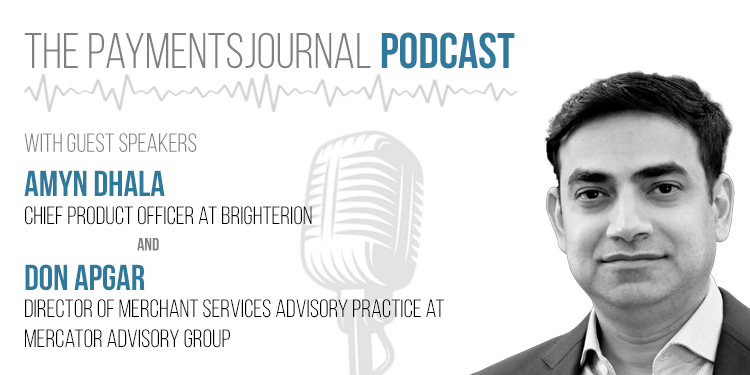Merchants, their acquiring banks, and payment service providers (PSPs) all face a daunting challenge: They’re under pressure to reduce ever-increasing transaction fraud while at the same time increasing revenue by taking on more volume with less friction for customers and merchants where sales are made.
According to Amyn Dhala, Chief Product Officer at Brighterion, a Mastercard company, this is where machine-learning models can get ahead of fraud trends.
In an episode of PaymentsJournal Podcast, Dhala and Don Apgar Director of Merchant Services Advisory Practice at Mercator Advisory Group, discussed how these fraud detection models are changing, the rapidly evolving fraud techniques that make the models valuable to merchants, banks, and PSPs, and the challenges in deploying the models.
Among their discussion points:
- How AI is evolving in detecting and blunting transaction fraud
- How AI can help ease the pain points of fighting fraud
- What it means for acquiring banks, PSPs, and large merchants to have a “market-ready” model
- How the return on investment looks for those employing such solutions
The Evolution of AI Models
The challenge, in sum, for acquiring banks, PSPs, and large merchants, is to decrease fraud while still increasing revenue. That is, handle more transactions, say yes to more credit applications and subsequent sales, minimize false positives in fraud detection, and still reduce the overall instances of fraud, all while making the processes for identifying and mitigating fraud as frictionless as possible.
And do all of that while accounting for fraud techniques that are ever changing and increasingly sophisticated.
In instances of known fraud, static rules for transactions have worked to the advantage of banks, PSPs, and merchants, Dhala noted. The problem lies in the evolution of fraud, which cries out for an equally evolving means of detecting it.
“As time progresses, these rules are not adaptive,” Dhala said. “They become a drag in terms of your operational performance.”
Enter AI models, which draw on large, world-class data sets for intelligence on how fraud is perpetrated, allowing for more accurate prediction, detection, and assessment of trends. The Mastercard Brighterion models, for example, are underpinned by “billions of transactions,” Dhala said.
Apgar noted that Mercator research into chargeback fraud grasped the scale of the challenge. “It almost became unmanageable without tools like machine learning and AI,” he said.
How AI Helps Ease Fraud-Fighting Pain Points
For any organization’s fight against fraud — be it a bank, a merchant, or a payment service provider — the coin of the realm is data. Data can provide a better perspective on fraud. The problem lies in extracting the data that can train a machine-learning model to predict, detect, and anticipate fraud. Further, organizations must contend with other issues, including:
- Explaining why and how a transaction was scored the way it was
- Adhering to the privacy norms of the applicable country where the transaction occurred
- Using the data sets in concert with existing systems
Dhala noted that a “market-ready” model should be able to handle these tasks at scale, whether on-premises or in the cloud. “Interoperability becomes crucial,” he said.
What It Means to Be “Market-Ready”
As fraud prevention has evolved from rules-based to initial fraud modeling to the most recent iteration, Dhala noted that so-called “market-ready” machine-learning models should be exceptionally accurate and based on a broad, deep set of historical data. Models should also be underpinned by billions of transactions containing data that can identify fraud and be able to learn from those patterns. Finally, machine-learning models should be “network agnostic” and customizable to relevant user specifications.
“It’s not just you feed your data into the grinder and the answers come out,” Apgar said. “The machine or algorithm is getting smarter by assessing the actual outcomes vs. the predicted outcomes, then using that knowledge to improve the score. When you talk about ‘market-ready,’ there’s already been a significant amount of development and additive value that’s come to the model.”
The Bottom Line — and the Top Line
Dhala said that fraud detection — relying on a vast trove of historical and ongoing data extraction as well as real-time scoring of all transactions — can be achieved while reviewing fewer than 1% of the transactions and with no customer interference.
But he also noted the top-line benefits. When issuing banks see fewer fraudulent transactions from a merchant or an acquirer, approval rates will go up, thus increasing revenue.
“The more data that you can review and the more efficiently you can review [the data] really is what drives that equation,” Apgar concluded.










